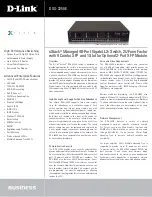
3-2
Features
Description
DLDP
In the use of fibers, link errors, namely unidirectional links, are likely to
occur. DLDP is designed to detect such errors. This document describes:
z
DLDP Introduction
z
Enabling DLDP
z
Setting DLDP Mode
z
Setting the Interval for Sending Advertisement Packets
z
Setting the DelayDown Timer
z
Setting the Port Shutdown Mode
z
Configuring DLDP Authentication
z
Resetting DLDP State
LLDP
LLDP enables a device to maintain and manage its own and its immediate
neighbor’s device information, based on which the network management
system detects and determines the conditions of the communications
links. This document describes:
z
Introduction to LLDP
z
Performing Basic LLDP Configuration
z
Configuring LLDP Trapping
MSTP
MSTP is used to eliminate loops in a LAN. It is compatible with STP and
RSTP. This document describes:
z
Introduction to MSTP
z
Configuring the Root Bridge
z
Configuring Leaf Nodes
z
Performing mCheck
z
Configuring the VLAN Ignore Feature
z
Configuring Digest Snooping
z
Configuring No Agreement Check
z
Configuring Protection Functions
Smart Link
Smart Link is a solution for active-standby link redundancy backup and
rapid transition in dual-uplink networking. This document describes:
z
Smart Link Overview
z
Configuring a Smart Link Device
z
Configuring an Associated Device
Monitor Link
Monitor link is a port collaboration function used to enable a device to be
aware of the up/down state change of the ports on an indirectly connected
link. This document describes:
z
Monitor Link Overview
z
Configuring Monitor Link
VLAN
Using the VLAN technology, you can partition a LAN into multiple logical
LANs. This document describes:
z
Introduction to VLAN
z
Types of VLAN
z
Isolate-user-vlan configuration
z
Introduction and Configuration of Voice VLAN
GVRP
GVRP is a GARP application. This document describes:
z
GARP overview
z
GVRP configuration
z
GARP Timers configuration











































